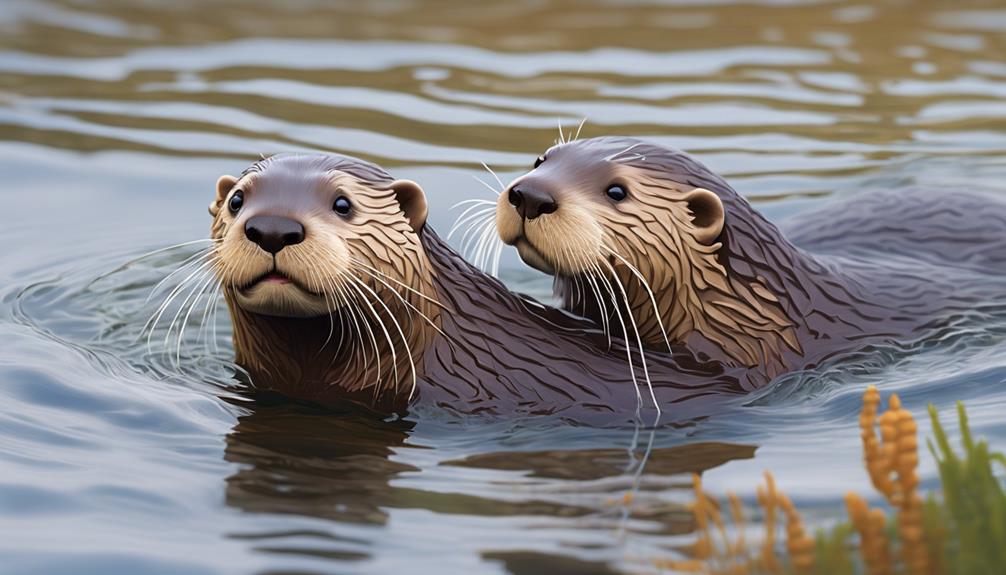Curious about the notion that otters hold hands while sleeping to prevent drifting apart?
The world of otters is filled with intriguing facts waiting to be explored.
As you venture into the details of their diet, reproduction habits, and classification, you’ll uncover a tapestry of information that sheds light on these enchanting creatures.
Prepare to be amazed by the complexity of otters’ lives and the vital role they play in the ecosystem.
Otter Species Overview

Interested in learning more about the diverse world of otters?
Otters are fascinating creatures with 13 known species globally, each with unique characteristics. From the smallest Asian small-clawed otter to the longest giant otter and the heaviest sea otter, otters come in various shapes and sizes. These aquatic mammals boast two layers of fur, long tails, and webbed feet, making them well-adapted to their watery habitats. Otters can be found in a range of aquatic environments like coastlines, rivers, lakes, marshes, and oceans.
They’re carnivorous animals with sharp teeth used for hunting a diet that includes fish, crustaceans, mollusks, birds, crayfish, frogs, abalone, clams, and mussels. Otters exhibit social or territorial behavior and are mostly active during the night, spending time grooming, cleaning their fur, and showcasing their intelligence.
With an average lifespan of 10-16 years and some living up to 20 years in captivity, otters are truly remarkable creatures worth exploring further.
Otter Physical Characteristics
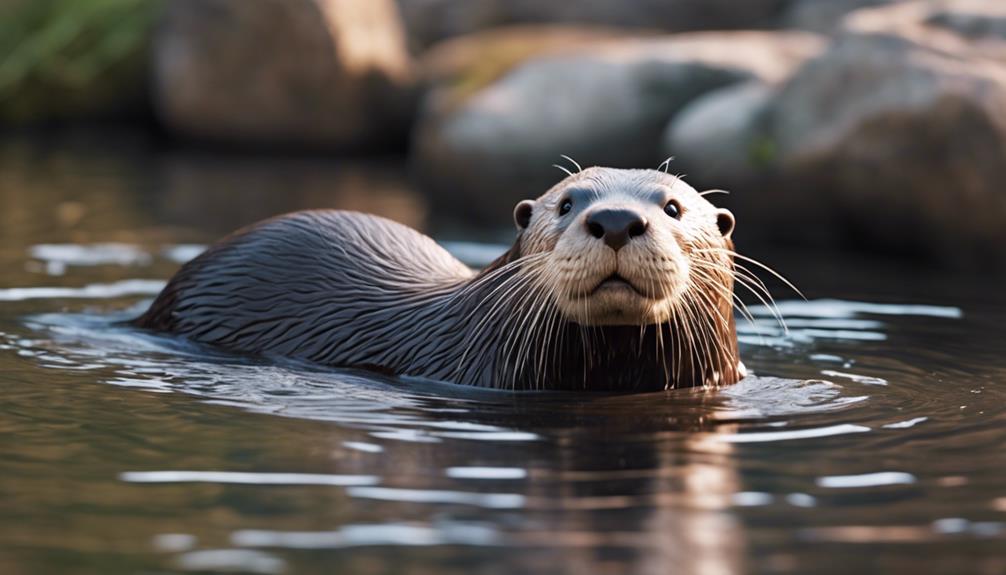
Otters’ physical characteristics include two layers of fur, long tails, and webbed feet, making them well-suited for their aquatic habitats.
The dual fur layers consist of a dense undercoat for insulation and longer guard hairs to repel water, keeping them warm while swimming. Their lengthy tails aid in steering and balancing as they navigate through water, contributing to their agility.
The webbing between their toes helps propel them efficiently through rivers, lakes, and oceans. Otters have small, rounded ears and nostrils that can close underwater, allowing them to dive and hunt for extended periods.
Their whiskers are highly sensitive, aiding in detecting prey in murky waters. With sharp claws for gripping slippery prey and breaking shells, otters are well-adapted for their carnivorous diet. These physical attributes collectively equip otters for a life spent mainly in aquatic environments.
Otter Dietary Habits
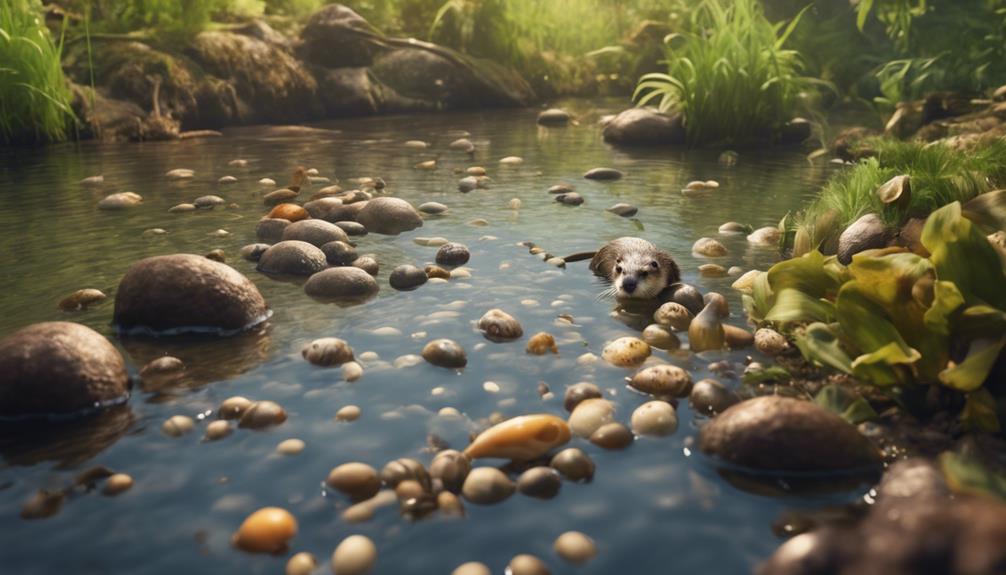
With their sharp claws and specialized teeth, otters showcase a diverse diet ranging from fish and crustaceans to mollusks and even birds. These agile swimmers are well-equipped to hunt underwater, preying on various aquatic creatures. Fish make up a significant portion of their diet, providing essential nutrients for their survival. Otters use their keen sense of smell to locate prey, then swiftly capture it with their nimble paws.
In addition to fish, otters also enjoy feasting on crustaceans like crabs and crayfish. Their strong jaws and sharp teeth enable them to crack open shells with ease, accessing the tasty meat inside. Mollusks such as clams, mussels, and abalone are another favorite food source for otters, requiring them to employ clever techniques to extract the soft flesh from the protective shells.
Furthermore, otters have been observed hunting and consuming birds, showcasing their adaptability and opportunistic nature. Whether diving for fish or foraging along the shoreline for other delectable treats, otters demonstrate remarkable skill and resourcefulness in their dietary habits.
Otter Reproduction Insights
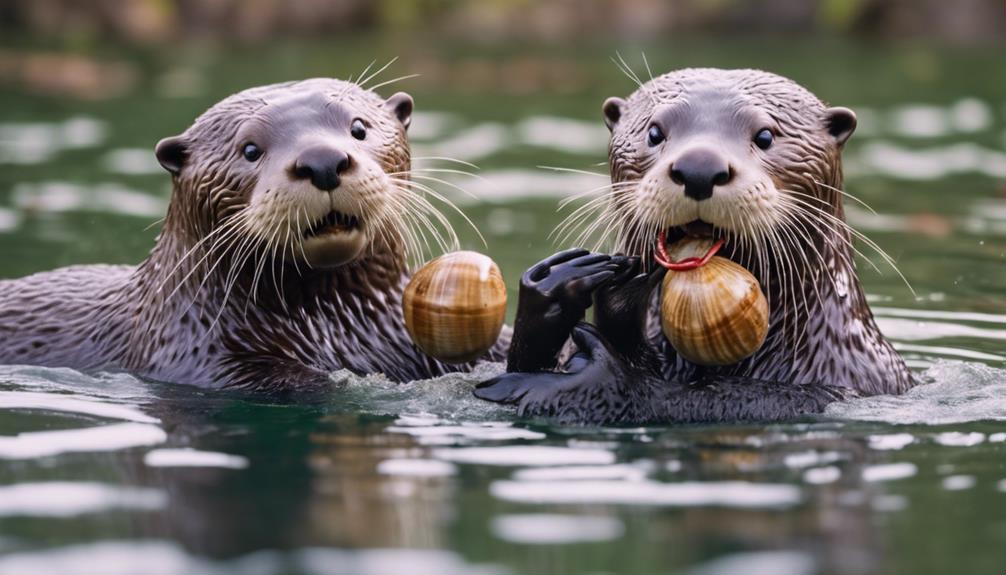
In exploring otter reproduction, investigate the intriguing mating rituals and gestation periods of these fascinating aquatic mammals. Otters typically mate in water, with gestation periods ranging from 60 to 86 days. Most otter species give birth to 1-2 pups at a time. Otter pups are born with closed eyes and rely on their mothers for care.
Young otters stay with their mothers for several months before becoming independent. Otters exhibit unique behaviors during mating, including vocalizations and playful interactions. Males may compete for females through displays of strength or agility.
The bonding between otter parents and their offspring is essential for the survival and development of the young. Understanding otter reproduction provides insights into their social dynamics and the challenges they face in maintaining healthy populations. By observing and studying otter mating behaviors, researchers can contribute to conservation efforts aimed at protecting these charismatic creatures for future generations to enjoy.
Otter Taxonomic Classification
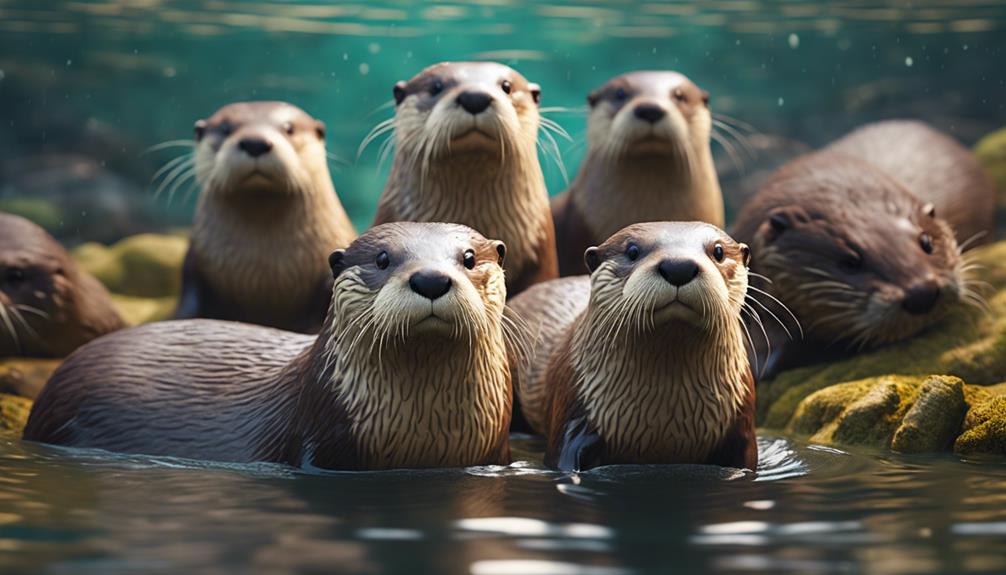
Diving into the intricate world of otter taxonomy exposes a diverse classification system reflecting their evolutionary relationships. Otters belong to the family Mustelidae and the subfamily Lutrinae. Within this classification, they’re further divided into different genera based on their unique characteristics.
For instance, the sea otter is classified under the Enhydra genus, while the Eurasian otter falls under the Lutra genus. These classifications help scientists understand the evolutionary history and relationships among otter species. Taxonomists continually refine the classification system as new information emerges, shaping our understanding of these fascinating aquatic mammals.
Otter Global Distribution
Exploring the worldwide presence of otters exposes their diverse habitats and distribution patterns. Otters are found on every continent except Australia and Antarctica, showcasing their adaptability to various environments. They inhabit a range of aquatic habitats such as rivers, lakes, marshes, and oceans. Otters have successfully adapted to both freshwater and marine ecosystems, demonstrating their versatility in different water bodies.
From the North American river otters to the Eurasian otters, each species has carved out its niche in specific regions around the globe. Their distribution reflects not only their ability to thrive in different conditions but also the historical separation of populations due to geographical barriers. Whether dwelling in the swift currents of rivers or the vast expanses of the ocean, otters have established themselves as resilient inhabitants of diverse aquatic landscapes, enthralling observers with their playful nature and remarkable hunting skills.
Otter Behavioral Patterns
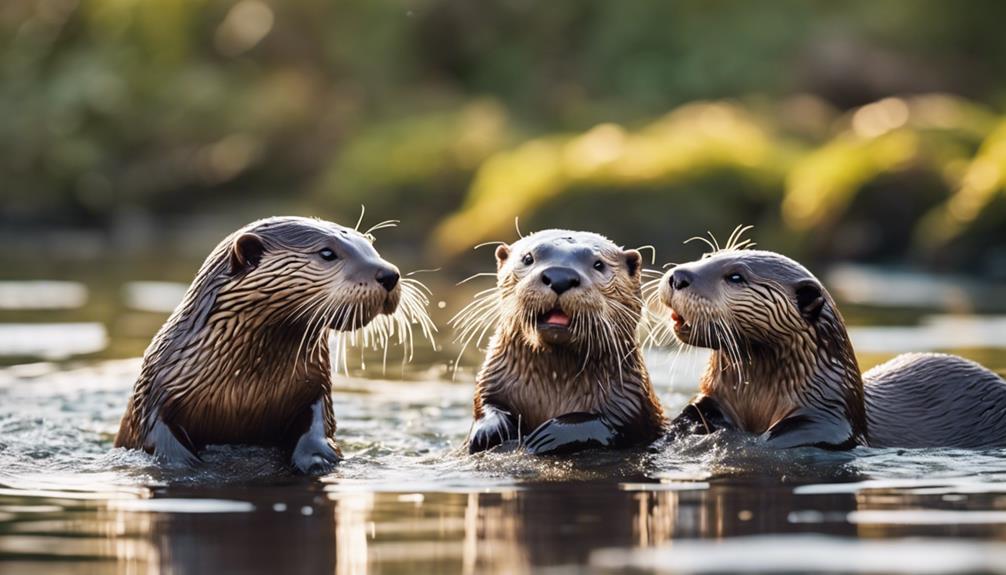
When observing otters in their natural habitat, you’ll notice a fascinating array of behavioral patterns that showcase their intelligence and adaptability. Otters are known for their playful nature, often engaging in activities like sliding down muddy slopes or playing with objects in the water. They’re also highly social animals, often forming close-knit family groups that work together for hunting and protection. Otters exhibit strong maternal instincts, with mothers providing extensive care and teaching their young essential skills for survival.
Moreover, otters display remarkable problem-solving abilities, using tools like rocks to crack open shells or solve puzzles to access food. Their inquisitive nature leads them to explore their surroundings thoroughly, learning and adapting to new environments quickly. Otters communicate through various vocalizations, body language, and scent marking, enabling them to convey information and establish territories effectively. Overall, otters’ behavioral patterns highlight their complex social structures, cognitive abilities, and remarkable adaptability to different habitats.
Otter Conservation Importance
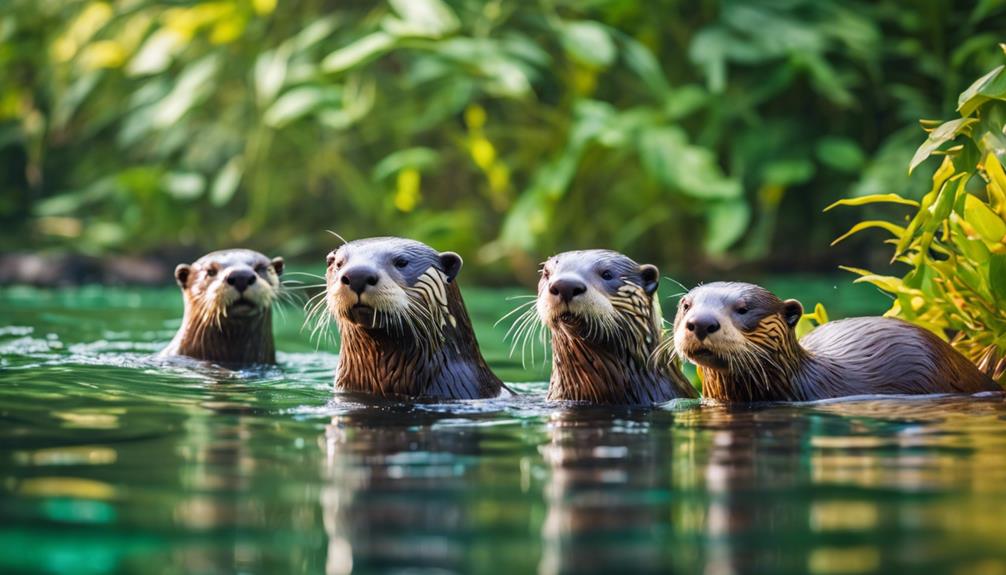
Conservation efforts are essential for safeguarding the future of otter populations worldwide. Otters play a critical role in maintaining the balance of aquatic ecosystems by controlling fish populations and preserving biodiversity. By protecting otters, you contribute to the health of their habitats, ensuring clean water sources and thriving aquatic life.
Habitat destruction, pollution, overfishing, and climate change pose significant threats to otters, making conservation initiatives imperative. Engaging in responsible tourism practices near otter habitats, supporting legislation that safeguards these animals, and promoting sustainable fishing methods are ways you can actively participate in otter conservation.
Additionally, spreading awareness about the importance of otters in their ecosystems and advocating for protected areas can help secure a better future for these charismatic creatures. Remember, your actions today can have a lasting impact on the survival of otter species for generations to come. Join the efforts to protect otters and their habitats, preserving these magnificent animals for the benefit of our planet.

Erzsebet Frey (Eli Frey) is an ecologist and online entrepreneur with a Master of Science in Ecology from the University of Belgrade. Originally from Serbia, she has lived in Sri Lanka since 2017. Eli has worked internationally in countries like Oman, Brazil, Germany, and Sri Lanka. In 2018, she expanded into SEO and blogging, completing courses from UC Davis and Edinburgh. Eli has founded multiple websites focused on biology, ecology, environmental science, sustainable and simple living, and outdoor activities. She enjoys creating nature and simple living videos on YouTube and participates in speleology, diving, and hiking.
🌿 Explore the Wild Side!
Discover eBooks, guides, templates and stylish wildlife-themed T-shirts, notebooks, scrunchies, bandanas, and tote bags. Perfect for nature lovers and wildlife enthusiasts!
Visit My Shop →
